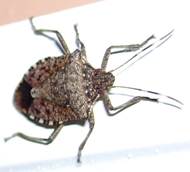Got Stink Bugs? Don't Make A Big Stink.

They don’t drink blood or spread deadly diseases, but brown marmorated stink bugs have been creating quite a “stink” as they have migrated from Pennsylvania throughout the mid-Atlantic states. These insects have invaded homes and damaged crops throughout Virginia and neighboring states. Like other insects, stink bugs are attracted to buildings because they provide shelter during the colder months of the year. While insecticides may knock the insects down, the most effective way to manage stink bugs indoors is to exclude the insect from the structure by eliminating access points. In fact, experts recommend that property owners do not use a pesticide when managing these pests indoors.
When an indoor infestation occurs, stink bugs can be vacuumed up and then placed in a sealed container and placed outdoors for trash collection. While this may result in an unpleasant odor, it will remove the pest without the use of unnecessary pesticides. Alternatively, small numbers of bugs can be swept up or knocked into a bucket of soapy water where they’ll drown.
Property owners or tenants should inspect buildings for gaps around windows, doors or utility conduits since they provide entry for stink bugs. These gaps need to be sealed with caulking, concrete, weather stripping or mesh to prevent entry. It is especially critical to look at the eaves and roof for any cracks or openings. Additionally, check screens on windows and vents for breaks and make any necessary repairs. If there are repeated infestations, it would indicate that there are still points of entry available to the pest. Perimeter pesticide applications made to the exterior of the home may reduce the numbers of insects entering the home but, again, it would only provide a temporary solution.
There are stink bug traps available commercially as well as some build your own instructions on the internet. Some of the commercial traps use insect pheromones while many of the homemade traps use light to attract the insect. There is little information available from researchers as to the long term effectiveness of traps in a management program but some homeowners have reported capturing large numbers of insects using traps. Management Resources
Environmental Protection Agency- Controlling Stink Bugs (Webpage)
Virginia Cooperative Extension-Brown Marmorated Stink Bug (Fact Sheet)
Virginia Tech –Field Guide to Stink Bugs
This guide has photos and information about the various stink bug species.
National Pesticide Information Center –Understanding and Controlling Stink Bugs
Northeastern IPM Center-StopBMSB.org (Website)
University of Maryland Extension-Brown Marmorated Stink Bug (Webpage)
Rutgers-New Jersey Agricultural Experiment Station- How to Control the Brown Marmorated Stink Bug
Penn State-College of Agricultural Sciences- Brown Marmorated Stink Bug (Fact Sheet)
When pesticides are used to manage any insect, be sure to read the label carefully and follow the Directions for Use. Some pesticides may not be labeled for indoor use so check for site specific information before purchasing any pesticide.
Hiring a professional? Check their qualifications
Individuals or businesses that apply pesticide commercially to control plant diseases must be licensed by the Office of Pesticide Services. In addition, their employees must be certified.To learn more visit the following sections of the website:
Is Your Pest Control Company Licensed?
Hiring a Professional